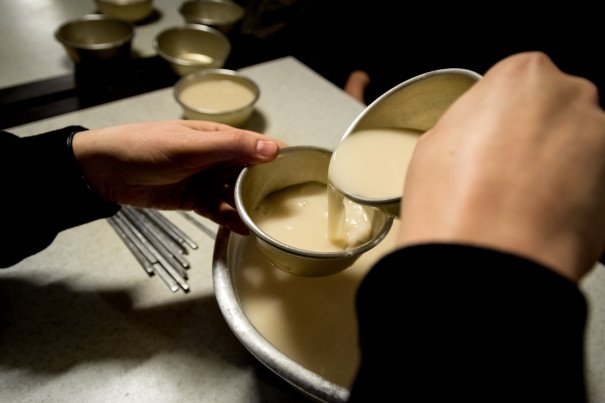
There’s One Place Left Where You Can Get Your Steel‑Pail Drink On

There’s One Place Left Where You Can Get Your Steel‑Pail Drink On
Makgeolli in Seoul
In a back-alley off a back-alley in a rapidly gentrifying neighborhood in Central Seoul sits one of the oldest extant bars in the city. Its real name is Jongno House, but nobody knows that, at least no one I know. They call it The Makgeolli Shack. And as Seoul has lurched ahead, developing at ludicrous speed, it has left behind a bent 75-year-old woman, who potters around long, white Formica tables, serving great bowls of makgeolli.
Makgeolli is a milky, fermented rice drink, between five and ten percent alcohol, and consumed by the gallon, particularly among older Koreans. It is typically served either in a large bowl or a copper kettle, and served into smaller drinking bowls with a ladle.
In nicer, and especially more touristed, bars and restaurants, it is presented in an ornate lacquered bowl, often with historical carvings, calligraphy, or other fine art drawn on it. The ladles are often fine-hewn pieces of art in themselves.
Not at the Makgeolli Shack. Here, where they haven’t seen a tourist since the 1988 Olympics, you get it in the same steel pail someone’s grandfather went fishing with. The waitress—call her grandmother, please—scoops it out of great clay urns that stand by the wall. There is no ladle, but rather a small plastic soup bowl for you to help yourself with.
There is no need to order. Makgeolli and an order of fried mackerel will be brought to you whether you like it or not. If you want to add something—a bottle of beer or soju, a plate of fried pork and kimchi—that’s up to you, but it’s only the grandmother working, and she’ll be with you when she’s done making sure everyone has their makgeolli and fish.
The Makgeolli Shack is not really a shack, though it has the structural integrity of one. For starters, it’s big, holding maybe 80 seats. It also has a second floor for those easy with risk.
It’s hard to say what it is exactly. The illegal addition on the building next door? A clapboard shed with just over five-foot-high ceilings that droop in some locations? A boarded-up carnival tent?
What it is is a beautiful museum piece, yet to be relegated to the museum. When the grandmother retires, will another replace her? Or will the fancy neighborhood around consume the Makgeolli Shack and its environs, and turn it into another overpriced experience for tourists?
There is a lot of debate over what authenticity means, and whether anything can really be authentic. But if the low ceilings, long white tables, graffitied walls, and steel pails at the Makgeolli Shack aren’t authentic, then the word has no meaning. And if it does close, another piece of the old Seoul will be gone with it, leaving nearly nowhere left to get your steel pail of drink on.
Photo credit: Jo Turner